|
ARLINGTON HOUSE
Historic Structures Report Phase II |

|
APPENDIX II
REPORT ON THE INVESTIGATION OF THE EXTERIOR PAINTS: CONDITIONS AND TREATMENTS
ARLINGTON HOUSE, ARLINGTON, VIRGINIA
Prepared by Frank G. Matero, Architectural Conservator, North Atlantic Historic Preservation Center/NARO July 1969
A. OBJECTIVE
An examination of the exterior paints of the Custis-Lee (Arlington) House was conducted on June 6, 1979, in order to evaluate the present conditions of the exterior finishes and to prepare recommendations for the cleaning, surface preparation, and repainting of the exterior.
B. DESCRIPTION
Site investigation (including surface moisture testing) and laboratory analysis of selected samples was conducted in order to determine the causes of the deterioration of the existing exterior finishes.
A review of the restoration files at the site and discussions with Mr. Lee Arnest of the National Capital Region Office, NPS, was undertaken in order to gain information about the historic finishes as well as the restoration/maintenance of the house over the years. According to views of the house (east facade) dated between c. 1967 and c. 1973 and correspondences on file regarding exterior paint investigation and analysis, it appears that the house was repainted twice during this period, the latter being the present finish (1973). In both instances, an alkyd resin-solvent thinned masonry paint (Re-Nu-It) was applied. In addition, the west (rear) and north facades were resurfaced in 1964. Photographic documentation indicates that these areas were sandblasted and received a Portland cement stucco applied over inserted wire mesh.
Visual inspection of the exterior surfaces was made from the ground with the aid of field binoculars where necessary. Access to the portico entablature for inspection and moisture testing was conducted on an extension ladder.
C. OBSERVATIONS ON THE EXTERIOR FINISHES
Examination indicated that in general the exterior paint film is in sound condition; however, localized adhesion failure, characterized by peeling, blistering, and surface checking was observed in the areas outlined below:
Central Block: East facade (figs. 1 & 2)
a. portico cornice and pediment soffit,
b. column capitals,
c. column shafts; upper third of eastern exposure,
d. south portico pilaster (southern exposure),
South Wing: East facade (fig. 3)
a. Detail.
General:
a. all window sill ledges and water table.
Paint failure in these areas can be attributed to several factors: improper surface preparation and paint application, unusual weather exposure, and faulty construction detailing. No indication of the deterioration of the paint film itself was observed due to masonry alkalinity or improper paint selection.
1. An examination of the wooden cornice and entablature of the portico exhibited an excessive build-up of paints characterized by severe peeling, cracking, and cross-grain checking (Figs. 2 & 4).
These conditions can be attributed to the differential expansion and contraction between the many paint layers and the wood substrate. In addition, these openings have allowed water to penetrate and swell the wood fibers thus breaking the bond between the paint and wood and causing further deterioration of the paint film.
2. The elastomeric sealant used to caulk the joints in the cornice area has lost its adhesive qualities and has pulled out of the joints thereby allowing water access into the wood and behind the paint film.
3. Moisture meter readings taken in this area indicated an unacceptable (approx. 15%) moisture content in the wood. Even higher readings (15-20%) were found in the lower architrave area and the abaci of the capitals. This high moisture condition has caused excessive peeling and general rot in this area and can be attributed to the retention and absorption of water caused by a metal flashing sleeve which was installed over the tops of each capital and around the lower edge of the architrave (Fig. 5).
4. The most widespread example of adhesion failure found on the masonry and wood surfaces was observed as a consistent peeling between the last finish coat and the present primer-finish coats. This condition can be attributed to improper surface preparation or incorrect paint application at the time of the last repainting (1973).
5. An examination of the window sills and upper ledges of the water table indicates severe blistering and paint film deterioration due to water penetration. Poor run-off detailing, minor structural cracking, and inflexible paint build-up are responsible.
6. In addition to the factors already cited, it is important to note that the heaviest concentration of peeling and blistering on both the wood and masonry has occurred on the unprotected south facade where extreme temperature cycling has accelerated the deterioration processes.
D. RECOMMENDATIONS
In order to correct the problems cited as responsible for the deterioration of the exterior paints, a comprehensive preservation/maintenance program should be developed and carried out as outlined below.
1. Surface Preparation
a. General
Proper surface preparation is extremely important to the success of any paint job. Without proper surface preparation, peeling and blistering of the paint may occur soon after the painting. If the old surface coatings are sound and show no peeling or blistering, they may be repainted readily after cleaning and repair of cracks and breaks. If the surface shows extensive flaking and peeling, then it will be necessary to remove the old coating completely. This will provide a firm surface to which paints will adhere. Before repainting, all surfaces should be washed with a non-ionic detergent.
b. Wood
The preparation of previously painted wood surfaces is more difficult than for new surfaces. The substrate, together with any coats of paint that may be on it, is the foundation for the new coating and must be in sound condition to support it. Paint removal is therefore essential and should be conducted in those areas where the paint is no longer well-bonded. Total paint removal destroys the historic record of paint colors and painting techniques (marbleizing, graining, etc.). It is therefore strongly recommended that paint not be stripped off those areas where it is securely bonded. After removal, but before repainting, areas should be photographed to show future researchers where old paint remains.
Methods of paint removal should be selected which are most appropriate for each location. Areas of peeling and flaking paint can be best removed by careful scraping and brushing to avoid any damage to delicate moldings or carved detailing. Conditions such as checking or alligatoring which also require complete removal can best be accomplished by the use of a non-alkali (organic solvent) paint stripper or an electric rod burner. Under no conditions should a high temperature hot air gun be used due to the potential fire hazard involved.
Those areas found to have a high moisture level should be closely examined after scraping and a search made to determine the source of water penetration. Although no blistering or peeling could be traced directly to a faulty gutter system, this system should nevertheless be examined in order to avoid future problems. It is recommended that the sheet flashing be removed from the abaci of the portico capitals in order to inspect and treat (if need be) the wood. After thorough drying, a low-viscosity epoxy (such as Seep and Seal, Arcon Products) used in conjunction with a water-repellant-wood preservative is advisable in these areas. Should new flashing be required, it should be designed to shed rather than retain moisture and be as inconspicuous as possible.
c. Metal
During inspection of the building, it was observed that the echini of the portico capitals were constructed (or sheathed?) in a sheet metal presumably galvanized iron. Although only 1-2 layers of paint were evident, these had peeled due to improper surface preparation of the metal. In order to insure secure bonding of the new paints, the best method of paint removal and cleaning for these areas is by low abrasive blasting. Tests should be carried out in order to determine the abradability of the metal and the type of abrasive selected.
d. Masonry (Stucco)
Microscopic examination of selected paint samples removed from the stuccoed walls and columns indicates in general that most of the previous paints were either removed or weathered (chalked) off over time. A heavy paint build-up was observed in the interstices of the coarse aggregate stucco of the raised basement. The earliest masonry paint layers found with any consistency were ochre washes believed (according to architect Arnest) to date to the late 19th century.
Proper surface preparation is essential if the masonry is to be repainted. An examination of the exterior surface indicates that most of the previous paints are sound and have only lightly chalked. As mentioned earlier, areas of peeling and flaking between the previous finish coat and the present primer exist due to improper surface preparation. Hand brushing with non-ferrous brushes will remove loose paint. Controlled field testing needs to be executed in order to assess the best method of paint removal.
All surface cracks and stucco loss need to be repaired prior to repainting. Surface cracks should be opened up in order to better receive the patching mix and be cleaned of all dirt and loose debris. Curing time for all new stucco work should not be less than 30 days to allow sufficient though probably not complete carbonation of the lime before painting.
2. Painting
a. Wood
In order to insure a durable and well-bonded protective paint finish on all exterior wood elements at Arlington House, it is strongly recommended that a traditional three-coat penetrating linseed oil primer system be applied as outlined below:
1. Apply by brush two thin coats of thinned raw linseed oil: First coat—50%raw linseed oil; 50% mineral spirits. Second coat—75% raw linseed oil; 25% mineral spirits.
2. After each application, rub linseed oil into the wood with burlap. This pushes the oil into the wood fibers.
3. Next apply one coat of paint: 75% finish paint or adjust to the weather. Add one-eighth teaspoon of Japanese Drier or Pratt and Lambert Drier on cloudy days.
4. Apply one coat of finish paint(s) thinned for brush mobility.
Both primer and finish paints should be an alkyd oil type. A fairly hard 'trim' alkyd should be used for all exterior woodwork (including shutters) so that chalking does not occur onto the masonry surfaces.
b. Metal
Should the metal-sheathed echini of the portico capitals prove to be galvanized iron upon closer inspection, then a chemical pre-treatment should be applied prior to repainting. After surfaces have been mechanically cleaned with either low abrasive blasting or wire brushing, a commercially available phosphate-phosphoric acid wash is recommended. After pre-treatment, a two-coat primer-finish system should be applied. In order to insure adhesion, a linseed-oil-zinc dust primer is recommended over a traditional alkyd primer.
c. Masonry
As mentioned earlier, there is no indication that the alkyd resin paint applied during the last two repaintings has failed due to vehicle breakdown by alkali attack. Discussions with Mr. Gene Goldsmith, Exhibit Specialist, National Park Service, have also verified the high quality performance of this paint when applied properly according to the manufacturer's directions.
Since it appears that very little new masonry work will be required, the use of an alkali-resistant coating (latex water-thinned emulsion) is unnecessary. Moreover, switching to a latex emulsion system may impair penetration of the new coat into the old alkyd-oil where well-adhered previous paint remains. A penetrating type surface conditioner, supplied by the same manufacturer of the finish paint, should be applied to these surfaces in order to strengthen and bind the previous paints to the underlying masonry surface.
It is essential that the paint manufacturer's directions be followed closely, particularly with regard to thinning, spreading rate, and application conditions, since all paints are not alike and surface conditions vary considerably.
d. Exterior Marbleization
According to early photographs of the house dated c. 1867, (Fig. 6) the present marbleizing appears to be fairly accurate in its overall tonality, pattern location, and style. Lacking in the present restoration, however, are the beautifully marbleized panel insets above the first story openings on the main portico facade. These appear to have been painted out by the turn of the century as indicated in a southeast view of the house taken in 1904. A comparison of values between the stucco walls and coarse aggregate raised basement in the 1867 photograph indicates that the basement story of the wings was painted a darker color than the rest of the masonry. In addition, it is interesting to note that by 1867 the west (rear) facade and chimneys were still exposed brick, and did not receive a stucco finish until some time before 1904.
According to a memo (June 18, 1973) concerning the exterior painting of Arlington House, no evidence of the original or 1867 stucco paint was found. Trim and entablature colors were reproduced based on surviving paint drips found under a molding on an original shutter.
It is this author's opinion that before the exterior is repainted again, an extensive paint investigation and analysis should be performed in order to determine the original colors. Sufficient photographic documentation of the exterior of the house exists to identify surviving features of the house and aid in the dating of the paint layers.
E. RECOMMENDATIONS SUMMARY
Obviously several approaches are possible for the restoration of the exterior paints at Arlington House. Based on the conditions and treatments already discussed, it is this author's opinion that the entire exterior need not be repainted at the present time. After specified problem areas have been prepared for repainting, the marbleizing could be in-painted by skilled professionals. As summarized below:
1. Prior to repainting, all surfaces should be washed with a mild non-ionic detergent that rinses clean leaving no film. Washing should proceed from top to bottom using sponges followed by a final rinse with clean water.
2. All construction details suspected of causing water penetration should be examined and repaired or replaced if necessary. This includes the roof and gutter system, all caulking, flashing, and exterior stairway construction.
3. All exterior woodwork including the entablature, cornice, doors, windows, enframements, and shutters should be repaired, consolidated, prepared, and repainted. Paints in these areas were found to be the most deteriorated and/or subject to excessive weather or wear.
4. Only those areas of the exterior masonry where the paint is poorly bonded and/or surface cracking and stucco loss has occurred should be repaired, prepared, and repainted.
5. A comprehensive preservation/maintenance program should be established including an inspection and washing of the exterior surfaces as described in Item 1 every six months.
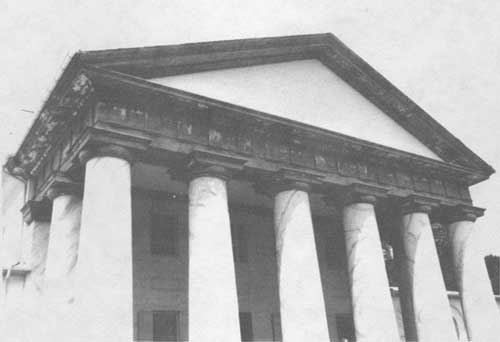
|
| Figure 1: Central Block, East Facade (July, 1979) |
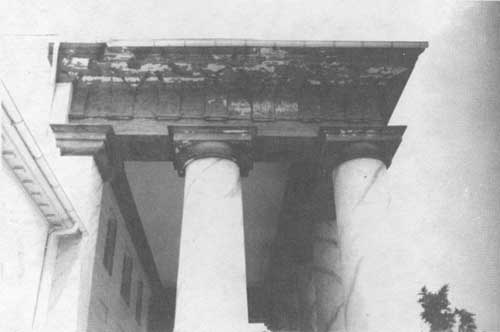
|
| Figure 2: South Side of Portico (July, 1979) |
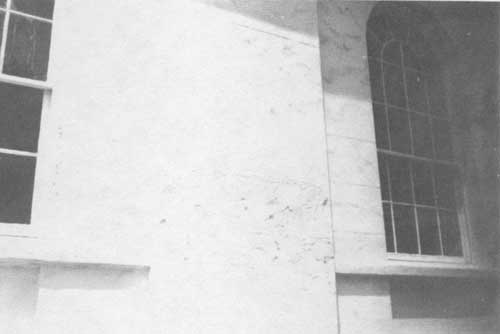
|
| Figure 3: Detail of South Wing, East Facade (July, 1979) |
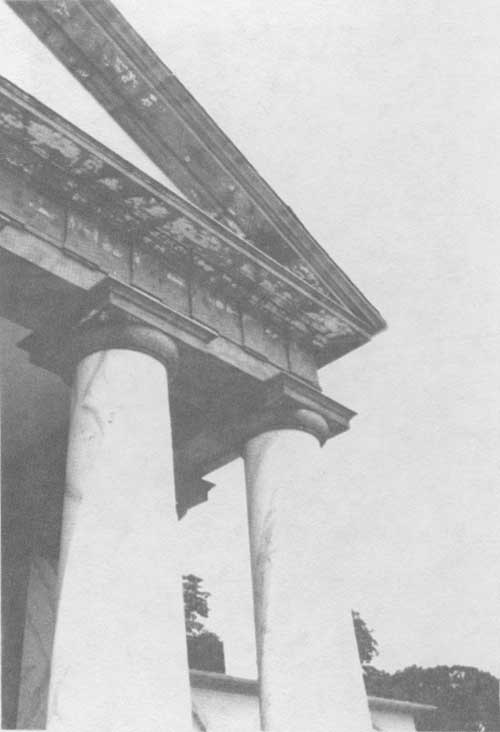
|
| Figure 4: North End of Portico (July, 1979) |
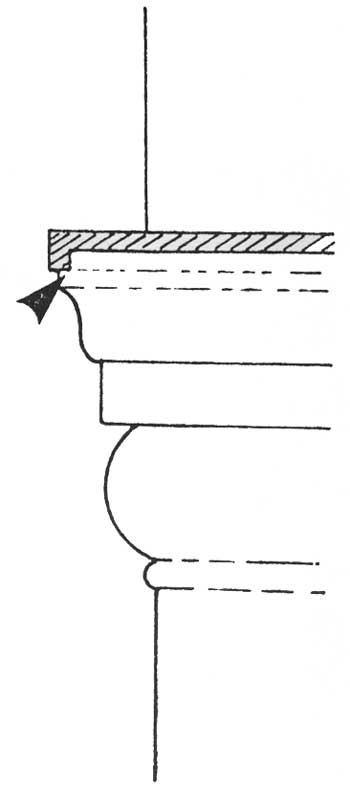
|
| Figure 5: Representative portico capital showing metal flashing sleeve installed over the echinus. Arrow indicates point of greatest water penetration. |
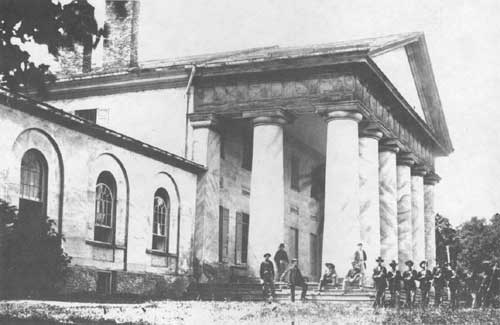
|
| Figure 6: Portico, 1867. |

March 21 1979
Mr. H. Lee Arnest, III
Project Architect
Branch of Historic Preservation
United States Dept. of the Interior
National Park Service
Washington, D.C. 20240
RE: GEORGE WASHINGTON MEMORIAL PARKSWAY
PACKAGE NO. 506, HISTORIC STRUCTURES
ARLINGTON HOUSE (H30-DSC-TNC)
SUBJECT: PAINT SAMPLES FROM ARLINGTON HOUSE.
Dear Mr. Arnest:
This will serve as a formal acknowledgement and report of your letter of February 9th, in which you enclosed samples of peeled material taken from the above building; also the writer's visit and personal inspection on March 6, 1979.
Laboratory examination of the samples sent in and personal inspection of the job proved conclusively the difficulty is not due to a product failure. Our recommendations for recoating this building are as follows:
1. All loose scale and peeling paint and any material that does not have a tight bond should be removed down to the bare surface. This may be accomplished by hand scraping, wire brushing and the use of a belt sander.
2. All cracks and openings up to 1/32nd of an inch should be patched with RE*NU*IT Exterior Wall Resurfacer (textured material). This should be done by forcing same in with a putty knife and simultaneously brushing over. Any wider cracks should be patched with suitable caulking compound or masonry patching compound as the surface requires.
3. All areas that are down to bare masonry and have been patched, should be spot primed by brushing on a coat of RE*NU*IT Exterior Wall Coating, which is a smooth finish. This coating should be allowed to dry for a minimum of 36 hours before the prime and finish coats are applied.
4. PRIME COAT— After the areas to be treated have been prepared, a prime coat consisting of one coat of RE*NU*IT Exterior Wall Coating brushed on should be applied on the prime coat. A minimum of one gallon of RE*NU*IT Exterior Wall Coating is to be used per 100 square feet.
5. FINISH COAT— After the prime coat is thoroughly dried and a minimum of one week has elapsed, the finish coat may be applied. RE*NU*IT Exterior Wall Coating should be applied by brushing using a minimum of one gallon per 150 square feet
6. SPECIAL INSTRUCTIONS: NO THINNING OF THE RE*NU*IT EXTERIOR WALL COATING SHOULD BE ALLOWED, WHATSOEVER. Also your specification should include caulking of windows and other essentials connected with an exterior coating job.
Preparation is the major part of this job. As discussed during my visit, we heartily recommend and cannot over-emphasize the fact that instead of this work going out on bid to an outside contract the job be done by your own maintenance crew. You have people who are thoroughly experienced with the proper application of these materials and by doing the work with your own crews you should be assured of proper preparation and application.
Very truly yours,
RE-NU-IT CORPORATION
A. H. Hardy
President
AHH: sc

April 4, 1980
MEMORANDUM FOR
Lee Arnest
National Park Service
Falls Church, Virginia
From: Paul G. Campbell
Building Materials
Group
Subject: Examination of the Curtis-Lee Mansion
This memorandum, for the record, concerns our inspection of the Curtis-Lee Mansion on March 21, 1980. Reviewing the structure and coating systems used, the following items are of interest:
• The building exterior is of stucco over brick.
• The columns were stucco over brick also. However, the capitals were of metal and wood. The brick shaft was coated with a black pitch-like substance before being stuccoed.
• Most of the building was restuccoed in 1965.
• Painting was in 1965 and 1973 using a textured "Renuit" coating. A "marbleized" finish was used as part of the finish coat.
• Rollers were used instead of brushes for the 1973 paint application.
Most of the paint failures appeared to be on the outer portions of the portico and columns and the east elevation. Other than having isolated paint failures, the other elevations were in good condition, especially the south elevation. The east elevation protected by the portico was of relatively good appearance. Examination of selected areas of paint failure indicated that the 1965 paint layer had alligatored and chalked. This could have accounted for some of the paint failures observed. Also, the 1973 paint layer was 10-20 mils which may have incurred some stress to the existing paint layers. Noticeable areas of spalling were noted on the columns which would have to be repaired before any repainting is undertaken.
In my opinion, the best course of action would be to remove all old paint (1965 and 1973) before repainting. I am biased towards a technique using paint stripper to soften the old paint and then applying high pressure water spray. The process would be repeated until all the paint would be removed. Another effective technique, potentially lower in cost, would be the use of walnut shells or similar type abrasives for an abrasive blast cleaning operation. Dave Henderson, NPS (FTS 8—234—6112), found this technique effective and you may wish to contact him about this method. Other variations on the abrasive blasting technique would be using sand at low pressures or a water-sand abrasive blasting. In any event, a test area should be used for paint removal and the results examined for both effectiveness of paint removal and preservation of the stucco substrate. Care should be exercised where the soft brick exposed by spalling would be subject to abrasive blasting.
After the paint is removed, necessary repairs may be made to the exposed substrate. The alkaline mortar/grout should be cured before painting. I feel that a two coat application of an acrylic emulsion paint, e.g., F.S. TT—P—19, applied at 250 to 300 square feet per gallon should provide a durable finish.
Photographs were taken of the problem areas and these will be available. If you have any questions, please contact me at 921-3114.
PGC:jb
| <<< Previous | <<< Contents>>> | Next >>> |
hsr1-phase2/app2.htm
Last Updated: 05-July-2011